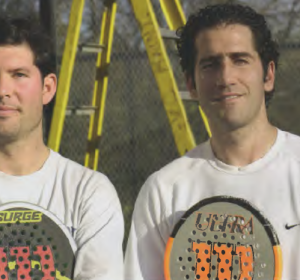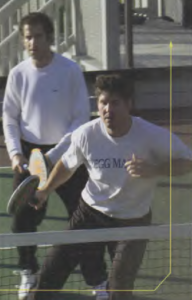Player Profiles: David Caldwell and Blake Cordish
PTM Editor Wayne Dollard reported:
PTM recently had the opportunity to sit down with Baltimore’s up-and-coming paddle sensations Blake Cordish (age 33) and David Caldwell (age 30) and asked about their remarkable history with tennis and their seamless transition to platform tennis.
Blake Cordish was born in Baltimore and played tennis at an early age. As a junior, he was ranked in the top 100 in the United States in singles and the top ten in doubles before going on to play for the varsity team at Princeton.
David Caldwell was raised in Danville, Virginia. As a junior, David was ranked #1 in the country. At the University of North Carolina, he improved and was a three-time All-American. By the late 1990′s, David was playing the top pros in the world at the Australian Open, French Open, and US Open. He was ranked in the top 150 on the ATP Tennis Tour.
David and Blake have been long-time friends. “From the age of ten, I grew up playing doubles on the junior tennis circuit with Blake’s younger brother, Reed,” David explained. He added, “Reed and I have remained close friends, in fact, after college Reed and I traveled together on the professional tennis tour. The Cordish family has always been an extended family for me.”
When David retired from the tennis tour, Blake hired David at his real estate development corporation, “The Cordish Company,” with divisions in retail, office, hospitality/gaming as well as operating divisions focused on restaurants/clubs, live music and film. David enthusiastically stated, “Real estate development appeals to my competitive instincts and in many ways is an intellectual extension of my sports background.’”
One of Blake’s mentors, David Iglehart, was a highly ranked national platform player (with his brother) and raved about the game. At his encouragement, Blake played platform tennis for the first time four years ago in the Baltimore League. Blake recalled, “I was always aware of the game growing up but never played. I instantly fell in love with platform tennis and the following fall, I introduced David to it. We played our first tournament in the fall of 2001. Naturally, we took a beating the first year or two. Needless to say, we played our share of back-draw matches but found the tournament competition invaluable. Our low point the first year was losing in a fifth round back-draw match of Nationals in a third set breaker to a guy who was cramping and alternatively chucking Red Bull beer on change-overs. It was both a humbling and soul-searching experience!” Blake added, “One of the major differences from conventional tennis is how much more quickly the momentum changes in platform tennis. In tennis, there is so much more time between points and change-overs to control tempo and momentum. As a result, platform places an increased emphasis on mental intensity. In addition, there is a huge mental difference with the realization in platform tennis that the point is almost basically never over. In terms of similarities, doubles tennis and platform tennis are both intellectually challenging in terms of strategy and positioning and require excellent communication between partners. As a result, in both sports it is a huge advantage to be close friends with your partner and have that level of trust.”
David expanded on Blake’s analysis, “One of the major differences I see between the sports is the flow and shot patterns within the points. Platform requires reprogramming your tennis brain in terms of how you approach the development of a point and how you react to the ball. Learning platform for us has been fascinating because, without formal training, in many ways it was trial and error. On a most basic level, the great similarity between the sports and the thing Blake and I enjoy most about both sports is that they represent competition in its purest sense. No coaches, no subs, both sports require competitors to just lay it on the line.”
David and Blake offered PTM a few recommendations for tennis pros or those new to the game. David explained, “My main piece of advice is to be mindful of the basics of paddle, but not at the expense of changing your core strengths. The game is certainly evolving and a major strength in tennis can more than likely be adapted to fit paddle and ultimately add a new dimension to the game.” Blake agreed, “Players with a tennis background should recognize they have a major advantage as they approach platform tennis and should build on those strengths. Many of the core fundamentals of the modern era of tennis such as semi-western forwards and extreme kick serves are all directly applicable to platform tennis.”
PTM asked David Caldwell what avenues their team has taken to better learn the sport? He responded, ‘We do read Platform Tennis Magazine, but in one sense we made a conscious effort early on to develop our game through competition and let our backgrounds in tennis be the driving force in the learning process. The theory is to not restrict the learning process with pre-conceived ideas about how to play. One great thing about sports is that they always evolve and the challenge is to figure out new ways to play and maintain an edge on the competition. The more talented tennis players we can get into the game the better. Platform tennis is clearly evolving and I am convinced that those with a tennis background will play a major role in the development of new shots and strategies on the platform tennis court.
As active APTA members, playing as many as six to ten sanctioned tournaments per season, David and Blake offered potential rule changes for the APTA to consider moving into the future. ‘We believe that lobs that land in the court and bounce over the wall should be in. We also feel that adding a second serve could be an interesting concept and change the basic dynamic of the sport.”
Regarding competitive play, Blake concluded, “We personally feel that tournament competition has been the key to our improvement. Every tournament we get to see new balls and we learn new things on the court. Our ultimate goal is to win a National Championship. We feel like we are still improving and we want to see how far we can go.”
Source: Platform Tennis Magazine, Vol 6., Issue 3, December 2004





